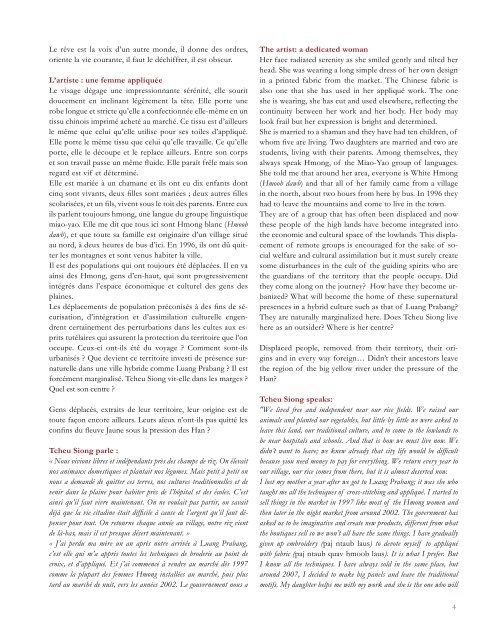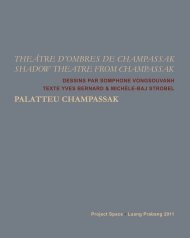LE GENIE AU BOUT DES CISEAUX ThE GENIE BEhIND ThE ...
LE GENIE AU BOUT DES CISEAUX ThE GENIE BEhIND ThE ...
LE GENIE AU BOUT DES CISEAUX ThE GENIE BEhIND ThE ...
You also want an ePaper? Increase the reach of your titles
YUMPU automatically turns print PDFs into web optimized ePapers that Google loves.
Le rêve est la voix d’un autre monde, il donne des ordres,<br />
oriente la vie courante, il faut le déchiffrer, il est obscur.<br />
L’artiste : une femme appliquée<br />
Le visage dégage une impressionnante sérénité, elle sourit<br />
doucement en inclinant légèrement la tête. Elle porte une<br />
robe longue et stricte qu’elle a confectionnée elle-même en un<br />
tissu chinois imprimé acheté au marché. Ce tissu est d’ailleurs<br />
le même que celui qu’elle utilise pour ses toiles d’appliqué.<br />
Elle porte le même tissu que celui qu’elle travaille. Ce qu’elle<br />
porte, elle le découpe et le replace ailleurs. Entre son corps<br />
et son travail passe un même fluide. Elle paraît frêle mais son<br />
regard est vif et déterminé.<br />
Elle est mariée à un chamane et ils ont eu dix enfants dont<br />
cinq sont vivants, deux filles sont mariées ; deux autres filles<br />
scolarisées, et un fils, vivent sous le toit des parents. Entre eux<br />
ils parlent toujours hmong, une langue du groupe linguistique<br />
miao-yao. Elle me dit que tous ici sont Hmong blanc (Hmoob<br />
dawb), et que toute sa famille est originaire d’un village situé<br />
au nord, à deux heures de bus d’ici. En 1996, ils ont dû quitter<br />
les montagnes et sont venus habiter la ville.<br />
Il est des populations qui ont toujours été déplacées. Il en va<br />
ainsi des Hmong, gens d’en-haut, qui sont progressivement<br />
intégrés dans l’espace économique et culturel des gens des<br />
plaines.<br />
Les déplacements de population préconisés à des fins de sécurisation,<br />
d’intégration et d’assimilation culturelle engendrent<br />
certainement des perturbations dans les cultes aux esprits<br />
tutélaires qui assurent la protection du territoire que l’on<br />
occupe. Ceux-ci ont-ils été du voyage ? Comment sont-ils<br />
urbanisés ? Que devient ce territoire investi de présence surnaturelle<br />
dans une ville hybride comme Luang Prabang ? Il est<br />
forcément marginalisé. Tcheu Siong vit-elle dans les marges ?<br />
Quel est son centre ?<br />
Gens déplacés, extraits de leur territoire, leur origine est de<br />
toute façon encore ailleurs. Leurs aïeux n’ont-ils pas quitté les<br />
confins du fleuve Jaune sous la pression des Han ?<br />
Tcheu Siong parle :<br />
« Nous vivions libres et indépendants près des champs de riz. On élevait<br />
nos animaux domestiques et plantait nos légumes. Mais petit à petit on<br />
nous a demandé de quitter ces terres, nos cultures traditionnelles et de<br />
venir dans la plaine pour habiter près de l’hôpital et des écoles. C’est<br />
ainsi qu’il faut vivre maintenant. On ne voulait pas partir, on savait<br />
déjà que la vie citadine était difficile à cause de l’argent qu’il faut dépenser<br />
pour tout. On retourne chaque année au village, notre riz vient<br />
de là-bas, mais il est presque désert maintenant. »<br />
« J’ai perdu ma mère un an après notre arrivée à Luang Prabang,<br />
c’est elle qui m’a appris toutes les techniques de broderie au point de<br />
croix, et d’appliqué. Et j’ai commencé à vendre au marché dès 1997<br />
comme la plupart des femmes Hmong installées au marché, puis plus<br />
tard au marché de nuit, vers les années 2002. Le gouvernement nous a<br />
The artist: a dedicated woman<br />
Her face radiated serenity as she smiled gently and tilted her<br />
head. She was wearing a long simple dress of her own design<br />
in a printed fabric from the market. The Chinese fabric is<br />
also one that she has used in her appliqué work. The one<br />
she is wearing, she has cut and used elsewhere, reflecting the<br />
continuity between her work and her body. Her body may<br />
look frail but her expression is bright and determined.<br />
She is married to a shaman and they have had ten children, of<br />
whom five are living. Two daughters are married and two are<br />
students, living with their parents. Among themselves, they<br />
always speak Hmong, of the Miao-Yao group of languages.<br />
She told me that around her area, everyone is White Hmong<br />
(Hmoob dawb) and that all of her family came from a village<br />
in the north, about two hours from here by bus. In 1996 they<br />
had to leave the mountains and come to live in the town.<br />
They are of a group that has often been displaced and now<br />
these people of the high lands have become integrated into<br />
the economic and cultural space of the lowlands. This displacement<br />
of remote groups is encouraged for the sake of social<br />
welfare and cultural assimilation but it must surely create<br />
some disturbances in the cult of the guiding spirits who are<br />
the guardians of the territory that the people occupy. Did<br />
they come along on the journey? How have they become urbanized?<br />
What will become the home of these supernatural<br />
presences in a hybrid culture such as that of Luang Prabang?<br />
They are naturally marginalized here. Does Tcheu Siong live<br />
here as an outsider? Where is her centre?<br />
Displaced people, removed from their territory, their origins<br />
and in every way foreign… Didn’t their ancestors leave<br />
the region of the big yellow river under the pressure of the<br />
Han?<br />
Tcheu Siong speaks:<br />
"We lived free and independent near our rice fields. We raised our<br />
animals and planted our vegetables, but little by little we were asked to<br />
leave this land, our traditional culture, and to come to the lowlands to<br />
be near hospitals and schools. And that is how we must live now. We<br />
didn’t want to leave; we knew already that city life would be difficult<br />
because yiou need money to pay for everything. We return every year to<br />
our village, our rice comes from there, but it is almost deserted now.<br />
I lost my mother a year after we got to Luang Prabang; it was she who<br />
taught me all the techniques of cross-stitching and appliqué. I started to<br />
sell things in the market in 1997 like most of the Hmong women and<br />
then later in the night market from around 2002. The government has<br />
asked us to be imaginative and create new products, different from what<br />
the boutiques sell so we won’t all have the same things. I have gradually<br />
given up embroidery (paj ntaub laus) to devote myself to appliqué<br />
with fabric (paj ntaub quav hmoob laus). It is what I prefer. But<br />
I know all the techniques. I have always sold in the same place, but<br />
around 2007, I decided to make big panels and leave the traditional<br />
motifs. My daughter helps me with my work and she is the one who will<br />
4



